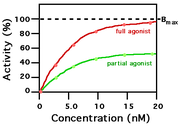
An agonist is a molecule that selectively binds to a specific receptor and triggers a response in the cell. It mimicks the action of an endogenous biochemical molecule (such as hormone or neurotransmitter) that binds to the same receptor. It is a drug molecule (synthesized outside an organism) that reproduces the action of an endogenous natural biochemical (synthesized inside an organism). An agonist is the opposite of an antagonist in the sense that while an antagonist also binds to the receptor, the antagonist does not activate the receptor and actually blocks it from activation by agonists. A partial agonist (such as buspirone, aripiprazole, bifeprunox or norclozapine) activates a receptor, but only produces a partial physiological response compared to a full agonist. A co-agonist works with other co-agonists to produce the desired effect together. Receptors can be activated or inactivated by endogenous (such as hormones and neurotransmitters) or exogenous (such as drugs) agonists and antagonists, resulting in stimulating or inhibiting the cell. To see how an agonist may activate a receptor see this link. Recently a novel theory called Functional Selectivity has been proposed that broadens the conventional definition of pharmacology.
Etymology
Stems from the Greek agonistes, 'contestant', from agon, 'contest'. An agonist is a chemical contestant or contender.




 216.73.216.81
216.73.216.81 User Stats:
User Stats:
 Today: 0
Today: 0 Yesterday: 0
Yesterday: 0 This Month: 0
This Month: 0 This Year: 0
This Year: 0 Total Users: 117
Total Users: 117 New Members:
New Members:
 216.73.xxx.xx
216.73.xxx.xx
 Server Time:
Server Time: